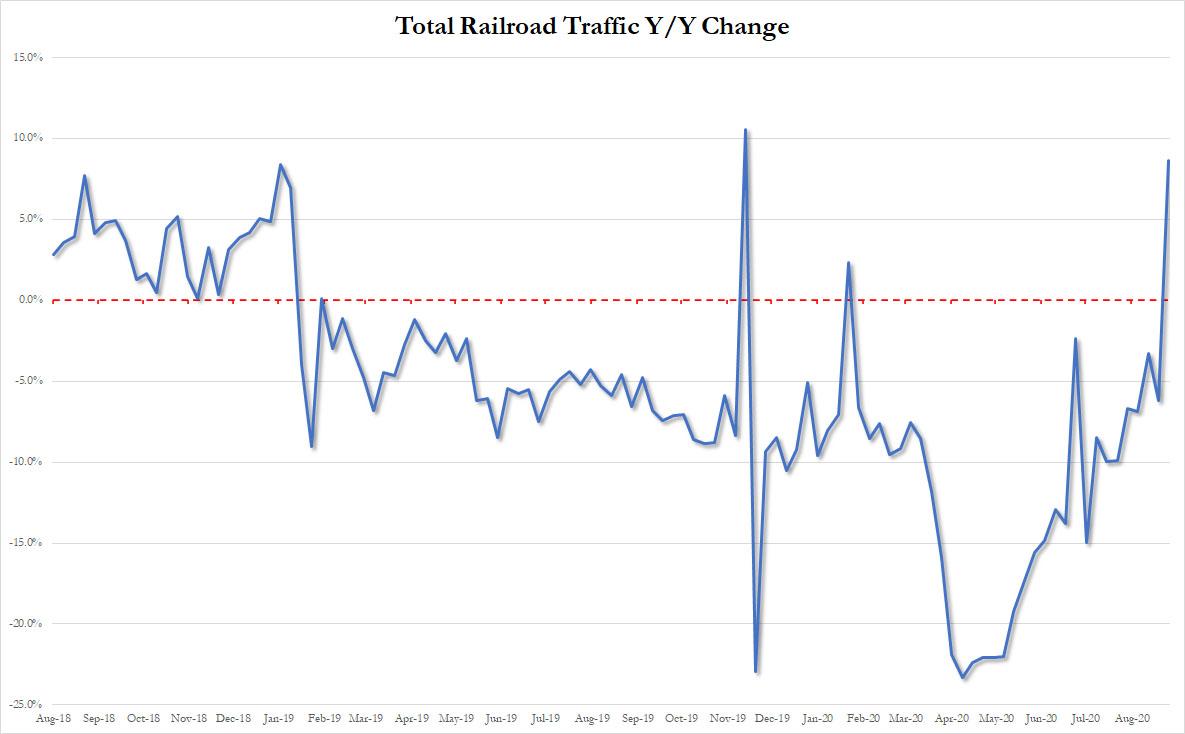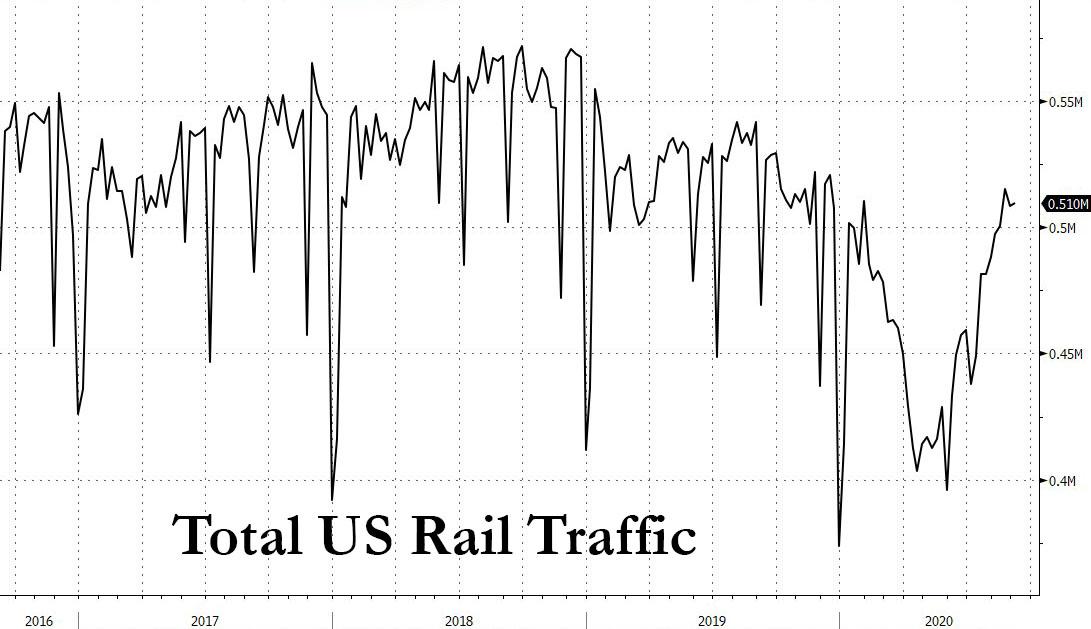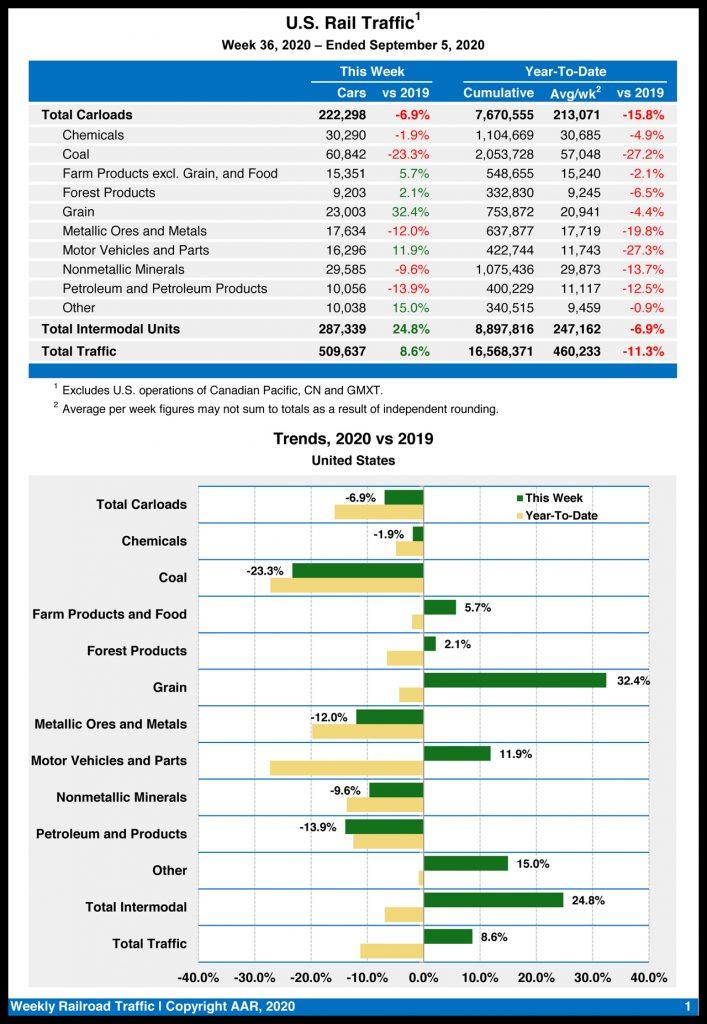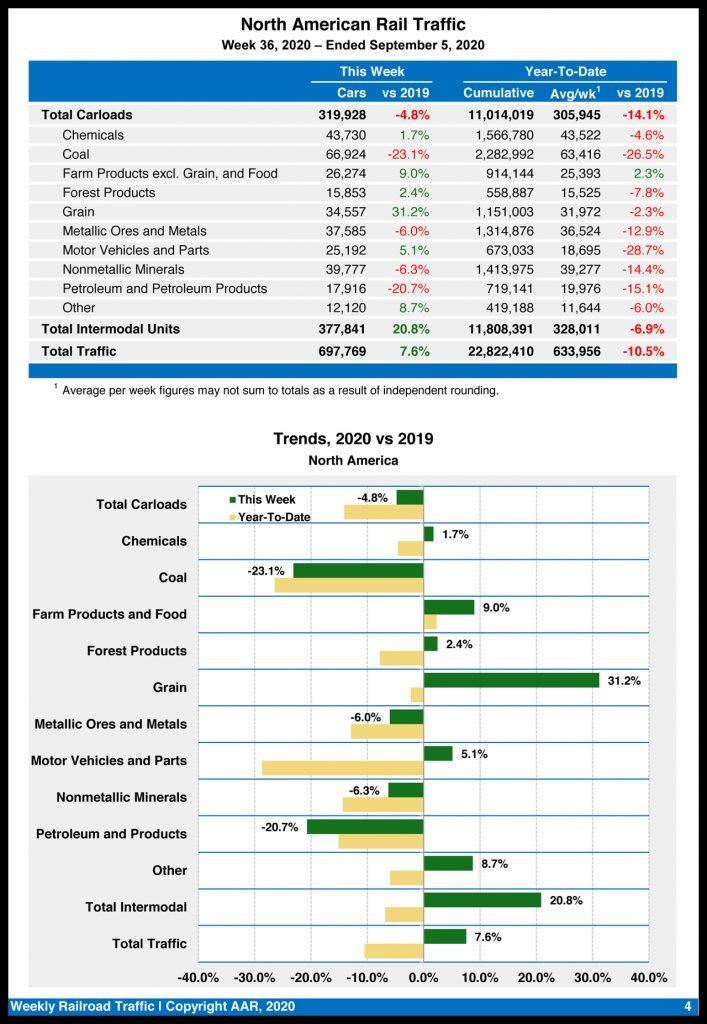The Urethane Blog
Everchem Updates
VOLUME XXI
September 14, 2023
Everchem’s exclusive Closers Only Club is reserved for only the highest caliber brass-baller salesmen in the chemical industry. Watch the hype video and be introduced to the top of the league: — read more
September 15, 2020
US Railroad Traffic Posts First Annual Jump Since The Start Of 2020
by Tyler Durden Tue, 09/15/2020 – 05:30
U.S. railroads just posted their first annual traffic gain in a very long time: according to Railway Age, for the week ending September 5, 2020, a surge of nearly 25% y/y in intermodal loadings more than offset a 7% decline in carload traffic, creating an overall annual gain of nearly 9%, the Association of American Railroads (AAR) reported Sept. 9.

Canadian and Mexican intermodal volumes also rose, driving a North American gain of nearly 21%.
Total U.S. rail traffic for the week ending Sept. 5 was 509,637 carloads and intermodal units, up 8.6% compared with the same week last year.
It’s unclear what prompted the 32% Y/Y surge in grain traffic which was the primary driver behind the week’s jump in intermodal, it’s also unclear if the traffic jump is sustainable but as the chart below shows, we are now entering a period where simply due to the base effect, rail traffic will soon be consistently stronger compared to late 2019 and early 2020.

Total carloads were 222,298, down 6.9% compared with the same week in 2019, but weekly intermodal volume was 287,339 containers and trailers, up 24.8%.

Five of the 10 carload commodity groups posted an increase compared with the same week in 2019. They included grain, up 5,630 carloads, to 23,003; motor vehicles and parts, up 1,729 carloads, to 16,296; and miscellaneous carloads, up 1,306 carloads, to 10,038. Commodity groups that posted decreases compared with the same week in 2019 included coal, down 18,495 carloads, to 60,842; nonmetallic minerals, down 3,159 carloads, to 29,585; and metallic ores and metals, down 2,396 carloads, to 17,634.
For the first 36 weeks of 2020, U.S. railroads reported cumulative volume of 7,670,555 carloads, down 15.8% from the same point last year; and 8,897,816 intermodal units, down 6.9% from last year. Total combined U.S. traffic for the first 36 weeks of 2020 was 16,568,371 carloads and intermodal units, a decrease of 11.3% compared to last year.
Total North American rail volume for the week on 12 reporting U.S., Canadian and Mexican railroads totaled 319,928 carloads, down 4.8% compared with the same week last year, and 377,841 intermodal units, up 20.8% compared with last year. Total combined weekly rail traffic in North America was 697,769 carloads and intermodal units, up 7.6%. North American rail volume for the first 36 weeks of 2020 was 22,822,410 carloads and intermodal units, down 10.5% compared with 2019.

Canadian railroads reported 78,580 carloads for the week, up 0.7%, and 73,558 intermodal units, up 11.3% compared with the same week in 2019. For the first 36 weeks of 2020, Canadian railroads reported cumulative rail traffic volume of 5,011,733 carloads, containers and trailers, down 8.2%.
Mexican railroads reported 19,050 carloads for the week, down 0.9% compared with the same week last year, and 16,944 intermodal units, up 4%. Cumulative volume on Mexican railroads for the first 36 weeks of 2020 was 1,242,306 carloads and intermodal containers and trailers, down 9.5% from the same point last year.
September 15, 2020
US Railroad Traffic Posts First Annual Jump Since The Start Of 2020
by Tyler Durden Tue, 09/15/2020 – 05:30
U.S. railroads just posted their first annual traffic gain in a very long time: according to Railway Age, for the week ending September 5, 2020, a surge of nearly 25% y/y in intermodal loadings more than offset a 7% decline in carload traffic, creating an overall annual gain of nearly 9%, the Association of American Railroads (AAR) reported Sept. 9.

Canadian and Mexican intermodal volumes also rose, driving a North American gain of nearly 21%.
Total U.S. rail traffic for the week ending Sept. 5 was 509,637 carloads and intermodal units, up 8.6% compared with the same week last year.
It’s unclear what prompted the 32% Y/Y surge in grain traffic which was the primary driver behind the week’s jump in intermodal, it’s also unclear if the traffic jump is sustainable but as the chart below shows, we are now entering a period where simply due to the base effect, rail traffic will soon be consistently stronger compared to late 2019 and early 2020.

Total carloads were 222,298, down 6.9% compared with the same week in 2019, but weekly intermodal volume was 287,339 containers and trailers, up 24.8%.

Five of the 10 carload commodity groups posted an increase compared with the same week in 2019. They included grain, up 5,630 carloads, to 23,003; motor vehicles and parts, up 1,729 carloads, to 16,296; and miscellaneous carloads, up 1,306 carloads, to 10,038. Commodity groups that posted decreases compared with the same week in 2019 included coal, down 18,495 carloads, to 60,842; nonmetallic minerals, down 3,159 carloads, to 29,585; and metallic ores and metals, down 2,396 carloads, to 17,634.
For the first 36 weeks of 2020, U.S. railroads reported cumulative volume of 7,670,555 carloads, down 15.8% from the same point last year; and 8,897,816 intermodal units, down 6.9% from last year. Total combined U.S. traffic for the first 36 weeks of 2020 was 16,568,371 carloads and intermodal units, a decrease of 11.3% compared to last year.
Total North American rail volume for the week on 12 reporting U.S., Canadian and Mexican railroads totaled 319,928 carloads, down 4.8% compared with the same week last year, and 377,841 intermodal units, up 20.8% compared with last year. Total combined weekly rail traffic in North America was 697,769 carloads and intermodal units, up 7.6%. North American rail volume for the first 36 weeks of 2020 was 22,822,410 carloads and intermodal units, down 10.5% compared with 2019.

Canadian railroads reported 78,580 carloads for the week, up 0.7%, and 73,558 intermodal units, up 11.3% compared with the same week in 2019. For the first 36 weeks of 2020, Canadian railroads reported cumulative rail traffic volume of 5,011,733 carloads, containers and trailers, down 8.2%.
Mexican railroads reported 19,050 carloads for the week, down 0.9% compared with the same week last year, and 16,944 intermodal units, up 4%. Cumulative volume on Mexican railroads for the first 36 weeks of 2020 was 1,242,306 carloads and intermodal containers and trailers, down 9.5% from the same point last year.
September 15, 2020
Sally Hopefully Has Minimal Impact on Urethane Raw Material Producers
Sally strengthens, to hit eastern Louisiana as a hurricane
Author: Al Greenwood
2020/09/14
HOUSTON (ICIS)–Tropical Storm Sally continued to strengthen on Monday as it remains on track to hit eastern Louisiana as a hurricane, threatening several petrochemical plants and refineries in the region.
Sally is about 140 miles (230 km) east-southeast of the mouth of the Mississippi river, according to the National Hurricane Center. Maximum wind speeds have since strengthened to 65 miles/hour.
Meteorologists expect Sally will continue strengthening until it becomes a hurricane later in the night. It could make landfall on Tuesday in Louisiana and again in Mississippi .
The following map shows the forecasted path of the storm.
Source: National Hurricane Center
STORM INFORMATION
A hurricane warning is in effect from Morgan City, Louisiana, to the border between Alabama and Florida. It also covers Lakes Pontchartrain and Maurepas as well as New Orleans, Louisiana.
Meteorologists do not expect Sally to strengthen into a major hurricane, which would have maximum sustained wind speeds of at least 111 miles/hour.
However, they do expect Sally to be a slow-moving storm, so it could produce a lot of rain. It estimates eight to 16 inches (20-41 cm) from the southeastern tip of Louisiana to the western part of the Florida panhandle. Some spots could receive 24 inches of rain.
The centre warned of life-threatening flash floods.
As Sally moves inland, it should continue producing rain in southeastern Mississippi and Alabama. Some portions could receive six to 12 inches.
The centre issued a storm-surge warning from Port Fourchon, Louisiana, to the border between Alabama and Florida. Lakes Pontchartrain, Maurepas and Borgne are also under storm-surge warnings, as well as Mobile Bay.
The coast of Mississippi could see the highest storm surges, with water levels reaching seven to 11 feet (two to three metres) from the mouth of the Mississippi river to Ocean Springs, Mississippi.
In Louisiana, the storm surge could reach four to six feet at Lakes Pontchartrain and Maurepas. It could reach three to five feet from Port Fourchon, Louisiana, to the mouth of the Mississippi river.
PLANTS
Hurricanes can disrupt plant operations in several ways. Strong winds can knock down electrical lines and cause power outages.
Heavy rains can flood roads, rail lines and even plants. Even if the plants suffer no damage, floods can prevent employees from showing up to work, and they can prevent units from receiving feedstock or delivering finished products.
Eastern Louisiana is home to many petrochemical plants and refineries, with several in Geismar, Plaquemine and Baton Rouge. Mississippi and Alabama also have some plants and refineries.
Phillips 66 shuts down its Belle Chasse refinery in Louisiana ahead of storm, the company said.
BASF said it is monitoring the storm and continuing with normal operations at its complex in Geismar, Louisiana. The plants make methylene diphenyl diisocycanate (MDI), toluene diisocyanate (TDI), surfactants and polyether polyols among other chemicals.
Pinnacle Polymers is running as usual at its plants in Garyville, Louisiana, according to a company source. It makes polypropylene (PP).
Shintech reported nothing major at its operations in Addis, Louisiana, according to a market source. The plant makes polyvinyl chloride (PVC).
ExxonMobil said its refinery in Baton Rouge, Louisiana, is operating normally.
Shell expects minimal effects to site operations. It has a complex in Geismar that makes ethylene oxide (EO), ethylene glycol (EG), alpha olefins, alcohols and surfactants.
Chevron is closely monitoring Tropical Storm Sally and following storm preparedness procedures at its onshore facilities, according to the company. It has a refinery in Pascagoula, Mississippi.
Sally is making landfall just weeks after Hurricane Laura made landfall in western Louisiana as a category 4 hurricane on 27 August.
The storm knocked down transmission lines serving Lake Charles, which has several petrochemical plants. Those plant are still down, and they may not resume operations until early to mid-October.
Those plants make ethylene dichloride (EDC) and vinyl chloride monomer (VCM) as well as PP and EG. The shutdowns have tightened markets for those products and for derivatives such as polyvinyl chloride (PVC) and polyethylene terephthalate (PET).
LOGISTICS
The Kansas City Southern railroad company said that New Orleans will shut down all flood gates by Monday. The shutdown of the flood gates will prevent interchange with eastern rail carriers.
Interchanges will not resume until the storm passes and the flood gates reopen, Kansas City said.
Norfolk Southern railroad warned that customers should expect delays as a result of the closing of the flood gates.
The port of New Orleans is closed with a condition of Zulu. When a port is under Zulu, gale force winds of at least 39 miles/hour are expected to arrive within 12 hours.
The port of Mobile in Alabama is under Yankee. It is closed to inbound traffic, and vessel-traffic-control measures are in effect on any movement within port.
The Louisiana Offshore Oil Port (LOOP) has suspended operations at the Marine terminal, it said. There are no interruptions at the Clovelly hub.
The LOOP is an offshore oil terminal that is 20 miles from the coast. It is the only US port capable of fully loading a very large crude carrier (VLCC).
CRUDE OIL
Hurricanes and tropical storms can disrupt oil and gas production in the Gulf of Mexico by causing companies to evacuate platforms and shut-in wells.
The Gulf of Mexico hosts several offshore oil wells, accounting for 17% of the nation’s crude production, according to the Energy Information Administration (EIA).
Oil companies had just recovered from Hurricane Laura when Sally became a tropical storm. The Bureau of Safety and Environmental Enforcement (BSEE) is expected to issue a report on any new shut-ins later in the day.
September 15, 2020
Sally Hopefully Has Minimal Impact on Urethane Raw Material Producers
Sally strengthens, to hit eastern Louisiana as a hurricane
Author: Al Greenwood
2020/09/14
HOUSTON (ICIS)–Tropical Storm Sally continued to strengthen on Monday as it remains on track to hit eastern Louisiana as a hurricane, threatening several petrochemical plants and refineries in the region.
Sally is about 140 miles (230 km) east-southeast of the mouth of the Mississippi river, according to the National Hurricane Center. Maximum wind speeds have since strengthened to 65 miles/hour.
Meteorologists expect Sally will continue strengthening until it becomes a hurricane later in the night. It could make landfall on Tuesday in Louisiana and again in Mississippi .
The following map shows the forecasted path of the storm.
Source: National Hurricane Center
STORM INFORMATION
A hurricane warning is in effect from Morgan City, Louisiana, to the border between Alabama and Florida. It also covers Lakes Pontchartrain and Maurepas as well as New Orleans, Louisiana.
Meteorologists do not expect Sally to strengthen into a major hurricane, which would have maximum sustained wind speeds of at least 111 miles/hour.
However, they do expect Sally to be a slow-moving storm, so it could produce a lot of rain. It estimates eight to 16 inches (20-41 cm) from the southeastern tip of Louisiana to the western part of the Florida panhandle. Some spots could receive 24 inches of rain.
The centre warned of life-threatening flash floods.
As Sally moves inland, it should continue producing rain in southeastern Mississippi and Alabama. Some portions could receive six to 12 inches.
The centre issued a storm-surge warning from Port Fourchon, Louisiana, to the border between Alabama and Florida. Lakes Pontchartrain, Maurepas and Borgne are also under storm-surge warnings, as well as Mobile Bay.
The coast of Mississippi could see the highest storm surges, with water levels reaching seven to 11 feet (two to three metres) from the mouth of the Mississippi river to Ocean Springs, Mississippi.
In Louisiana, the storm surge could reach four to six feet at Lakes Pontchartrain and Maurepas. It could reach three to five feet from Port Fourchon, Louisiana, to the mouth of the Mississippi river.
PLANTS
Hurricanes can disrupt plant operations in several ways. Strong winds can knock down electrical lines and cause power outages.
Heavy rains can flood roads, rail lines and even plants. Even if the plants suffer no damage, floods can prevent employees from showing up to work, and they can prevent units from receiving feedstock or delivering finished products.
Eastern Louisiana is home to many petrochemical plants and refineries, with several in Geismar, Plaquemine and Baton Rouge. Mississippi and Alabama also have some plants and refineries.
Phillips 66 shuts down its Belle Chasse refinery in Louisiana ahead of storm, the company said.
BASF said it is monitoring the storm and continuing with normal operations at its complex in Geismar, Louisiana. The plants make methylene diphenyl diisocycanate (MDI), toluene diisocyanate (TDI), surfactants and polyether polyols among other chemicals.
Pinnacle Polymers is running as usual at its plants in Garyville, Louisiana, according to a company source. It makes polypropylene (PP).
Shintech reported nothing major at its operations in Addis, Louisiana, according to a market source. The plant makes polyvinyl chloride (PVC).
ExxonMobil said its refinery in Baton Rouge, Louisiana, is operating normally.
Shell expects minimal effects to site operations. It has a complex in Geismar that makes ethylene oxide (EO), ethylene glycol (EG), alpha olefins, alcohols and surfactants.
Chevron is closely monitoring Tropical Storm Sally and following storm preparedness procedures at its onshore facilities, according to the company. It has a refinery in Pascagoula, Mississippi.
Sally is making landfall just weeks after Hurricane Laura made landfall in western Louisiana as a category 4 hurricane on 27 August.
The storm knocked down transmission lines serving Lake Charles, which has several petrochemical plants. Those plant are still down, and they may not resume operations until early to mid-October.
Those plants make ethylene dichloride (EDC) and vinyl chloride monomer (VCM) as well as PP and EG. The shutdowns have tightened markets for those products and for derivatives such as polyvinyl chloride (PVC) and polyethylene terephthalate (PET).
LOGISTICS
The Kansas City Southern railroad company said that New Orleans will shut down all flood gates by Monday. The shutdown of the flood gates will prevent interchange with eastern rail carriers.
Interchanges will not resume until the storm passes and the flood gates reopen, Kansas City said.
Norfolk Southern railroad warned that customers should expect delays as a result of the closing of the flood gates.
The port of New Orleans is closed with a condition of Zulu. When a port is under Zulu, gale force winds of at least 39 miles/hour are expected to arrive within 12 hours.
The port of Mobile in Alabama is under Yankee. It is closed to inbound traffic, and vessel-traffic-control measures are in effect on any movement within port.
The Louisiana Offshore Oil Port (LOOP) has suspended operations at the Marine terminal, it said. There are no interruptions at the Clovelly hub.
The LOOP is an offshore oil terminal that is 20 miles from the coast. It is the only US port capable of fully loading a very large crude carrier (VLCC).
CRUDE OIL
Hurricanes and tropical storms can disrupt oil and gas production in the Gulf of Mexico by causing companies to evacuate platforms and shut-in wells.
The Gulf of Mexico hosts several offshore oil wells, accounting for 17% of the nation’s crude production, according to the Energy Information Administration (EIA).
Oil companies had just recovered from Hurricane Laura when Sally became a tropical storm. The Bureau of Safety and Environmental Enforcement (BSEE) is expected to issue a report on any new shut-ins later in the day.
September 14, 2020
Dow to sell Gulf Coast marine, terminal operations in $620M deal
Sep. 14, 2020 7:11 AM ET|About: Dow Inc. (DOW)|By: Carl Surran, SA News Editor
Dow Inc. (NYSE:DOW) agrees to sell some U.S. Gulf Coast marine and terminal operations and assets to a joint venture owned by tank storage company Royal Vopak and BlackRock’s Global Energy & Power Infrastructure Fund for $620M.
The sale includes marine and storage terminal operations and assets at Dow’s sites in Plaquemine and St. Charles, La., and Freeport, Tex.
Dow and Vopak also will enter into long-term service agreements, ensuring services for existing Dow businesses at the in-scope sites.
In July, Dow agreed to sell its rail infrastructure assets at six North American sites to Watco Companies for ~$310M.

